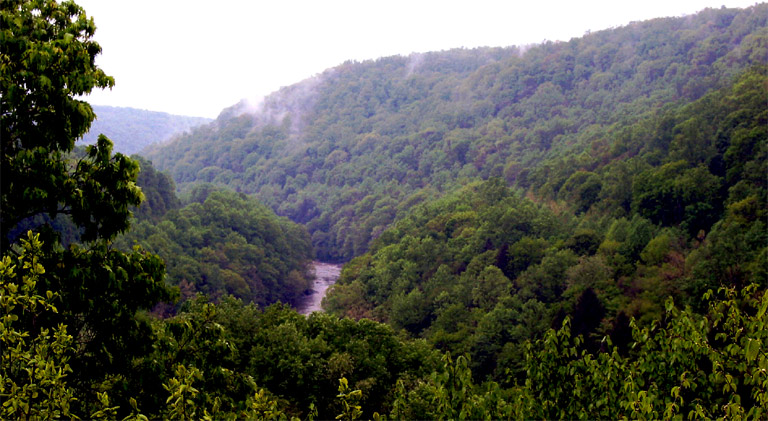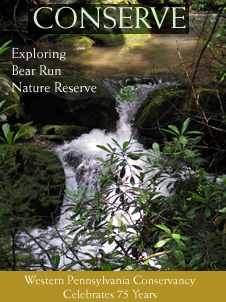
Bear Run: At roughly 40 degrees north latitude, and about 2,200 feet above the Earth’s oceans, the Bear Run Nature Reserve folds into the coves and hollows of the Alleghenies’ western slope. Thousands drive by it on their way to Ohiopyle or Fallingwater but the reserve’s complexity, beauty and expanse do not reveal themselves through windshield glass. Bear Run’s boundaries form a crude 5,000-acre arrowhead, broader to the east along Laurel Hill’s crest, so that a motorist sees only a right-ofway slice of the tapering western tip. Hikers, though, know a spot not far
from the Bear Run barn along the Wagon
Trail where much of the reserve looms ahead
and above. It’s just east of the juncture with
Aspen Trail, where spruce plantings stand
north of the path, on your left if you’re
headed out. Their dark branches, and the
bulk of Maple Summit to the south, frame a
view of the reserve’s eastern heights.
Still, Bear Run’s best invitation is to reflect in solitude on the here and now, on process and place. A giant red oak lies fallen across the Ridge Trail, prostrate hint at a forest in flux. Within the radius of its own prone length, still standing, barkless, are dozens of its bleached brethren, posing the same uncertainty as oak forests everywhere. Moving downslope, you feel the imperative of Bear Run itself...to seek eternally the great Mexican Gulf...in your own knees. You must work to hold yourself back. The stream, though, does not work. It careens and piles against the mountain’s stony ribs. Its descent, obstacles not withstanding, is the most certain of constants. Here, perhaps because they harbor the determined stream, hemlock coves foretell a more stable community than the oaks far above. Where the trail crosses a Bear Run tributary, the bulk of a hemlock stump juts as high as a hiker’s shoulders. Where the bole parted in some storm or wind, the stump is 40 inches across by the rough measurement of an outstretched hand span. Its top reclines nearby, furrow-barked and studded with snags. On this particular day in late autumn, at least three species of moss mat the stump’s splintered top. From within the mat sprout 39 hemlock seedlings, some five inches tall and the same deep green as the surrounding glen. Most, though, are an inch high at most, arrayed with a dozen to 15 needles, pale yellow-green, as the older sprouts might appear if sunlight were ever to sift through the dense canopy above. All else equal, there will be hemlocks here for a long time to come. It is a good spot for pondering the future. Listen to the wind here long enough
and it yields a sense of the knit of wandering
air, treetop, earth and root. It consorts with
the hemlocks, then mounts the ridge to
buffet the oaks. Heard casually, as background, the wind sounds much the same in
both locations, but there are differences
around its edges, suggesting that if one spent
enough time in the woods, then suddenly
lost one’s sight, it would be possible to know
hemlock wind from spruce, poplar wind Somewhere on the contours above Bear Run is a zone where it is hard to discern the hemlock wind from the stream’s liquid rush. There, where the calls of wind and water blend, may be, if you seek it, the very heart of a good wild place yet remaining. Ben Moyer, a native western Pennsylvanian, is an award-winning author and essayist whose writing on nature and conservation issues has appeared in numerous state, regional and national publications. He is also an outdoors columnist for the Pittsburgh Post- Gazette. In 2002, Moyer was honored as"Conservation Communicator of the Year" by Audubon Pennsylvania and The Nature Conservancy. |

Read next article | e-CONSERVE Home | WPC Home |
Conservation | | Fallingwater | | Gardens | | Join WPC | | Contact | | Press Room

